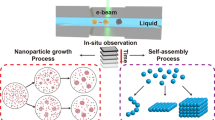Abstract
We investigated the potential of the Cu(I) catalyzed azide-alkyne cycloaddition between water soluble azide and alkyne functionalized gold nanoparticles in terms of dimer formation via a solid phase support. Alkyne and azide lipoic acid derivatives are prepared and utilized as stabilizing ligands for 15 nm gold colloids. For the solid phase supported click reaction first citrate stabilized gold nanoparticles are immobilized on amine terminated silicon wafers. In the following step the citrate ligands of the upper free accessible nanoparticle surface are exchanged against a mixture of the alkyne derivative of lipoic acid and lipoic acid. Upon addition of lipoic acid/lipoic acid azide derivative stabilized 15 nm gold nanoparticles and the Cu(I) catalyst solution covalent interparticle coupling between immobilized and gold nanoparticles added is achieved. The formed structures are analyzed by scanning electron microscopy directly on the solid support. It is demonstrated that the yield of dimeric structures on the solid phase support increases with increased molar ratio of the catalyst, thus indicating that dimers are indeed formed by covalent bond formation. Upon treatment with ultrasound the formed structures could be released and detected with transmission electron microscopy measurements.










Similar content being viewed by others
References
R. Shenhar and V. M. Rotello (2003). Acc. Chem. Res. 36, 549–561.
G. Schmid, Nanoparticles, 2nd edn. (Wiley, Weinheim, 2003).
E. Locatelli, G. Ori, M. Fournelle, R. Lemor, M. Montorsi, and M. C. Franchini (2011). Chem. Eur. J. 17, (33), 9052–9056.
M. Homberger and U. Simon (2010). Philos. Trans. A 368, 1405–1453.
M.-C. Daniel and D. Astruc (2004). Chem. Rev. 104, 293–346.
E. Boisselier and D. Astruc (2009). Chem. Soc. Rev. 38, 1759–1782.
N. L. Rosi and C. A. Mirkin (2005). Chem. Rev. 105, 1547–1562.
T. -J. Yim, Y. Wang, X. Zhang (2008). Nanotechnology 19, 435605.
M. G. Blaber and G. C. Schatz (2011). Chem. Commun. 47, 3769–3771.
P. Alessio, C. J. L. Constantino, R. F. Aroca, O. N. Oliveira Jr. (2010). J. Chil. Chem. Soc. 55(4), 469.
J. P. Novak and D. L. Feldheim (2000). J. Am. Chem. Soc. 122, (16), 3979–3980.
J. P. Hermes, F. Sander, T. Peterle, C. Cioffi, P. Ringler, T. Pfohl, and M. Mayor (2011). Small 7, (7), 920–929.
B. Dong, B. Li, and C. Y. Li (2011). J. Mater. Chem. 21, 13155–13158.
R. Sardar, T. B. Heap, J. S. Shumaker-Parry (2007). J. Am. Chem. Soc. 129(17), 5356–5357 .
J. S. Shumaker-Parry, R. Sardar, patent application number: 20090256116, publication date: 10/15/2009.
R. Huisgen (1961). Proc. Chem. Soc. 357–396.
H. C. Kolb, M. G. Finn, and K. Barry Sharpless (2001). Angew. Chem. Int. Ed. 40, (11), 2004–2021.
W. H. Binder, L. Petraru, R. Sachenshofer, and R. Zirbs (2006). Monatsh. Chem. 137, 835–841.
J. L. Brennan, N. S. Hatzakis, T. R. Tshikhudo, N. Dirvianskyite, V. Razumas, S. Patkar, J. Vind, A. Svendsen, R. J. M. Nolte, A. E. Rowan, and M. Brust (2006). Bioconjugate Chem. 17, 1373–1375.
R. Voggu, P. Suguna, S. Chandrasekaran, and C. N. R. Rao (2007). Chem. Phys. Lett. 443, 118–121.
N. Lia and W. H. Binder (2011). J. Mater. Chem.. doi:10.1039/C1JM11558H.
M. Fischler and U. Simon (2009). J. Mater. Chem. 19(11), 1518–1523.
M. Fischler, U. Simon, H. Nir, Y. Eichen, E. A. Burley, J. Gierlich, P. M. E. Gramlich, and T. Carell (2007). Small 3, (6), 1049–1055.
J. Turkevich, P. C. Stevenson, and J. J. Hillier (1953). Phys. Chem. 57, 670–673.
J. M. Abad, S. F. L. Mertens, M. Pita, V. M. Fernández, and D. J. Schiffrin (2005). J. Am. Chem. Soc. 127, 5689–5694.
V. V. Rostovtsev, L. G. Green, V. V. Fokin, and K. Barry Sharpless (2002). Angew. Chem. 114(14), 2708–2711.
V. V. Rostovtsev, L. G. Green, V. V. Fokin, and K. Barry Sharpless (2002). Angew. Chem. Int. Ed. 41(14), 2596–2599.
S. Berchmans, P. John Thomas, and C. N. R. Rao (2002). J. Phys. Chem. B 106, 4647–4651.
S. Gilles, C. Kaulen, M. Pabst, U. Simon, A. Offenhäusser, and D. Mayer (2011). Nanotechnology 22, 295301.
Acknowledgments
This work was supported by the Excellence Initiative of the German federal and state government and by the Jülich Aachen Research Alliance (JARA). We thank Dr. Corinna Kaulen for fruitful discussions.
Author information
Authors and Affiliations
Corresponding author
Additional information
JARA - Fundamentals of Future Information Technology (FIT)
Electronic supplementary material
Below is the link to the electronic supplementary material.
Rights and permissions
About this article
Cite this article
Homberger, M., Schmid, S., Timper, J. et al. Solid Phase Supported “Click”-Chemistry Approach for the Preparation of Water Soluble Gold Nanoparticle Dimers. J Clust Sci 23, 1049–1059 (2012). https://doi.org/10.1007/s10876-012-0494-7
Received:
Published:
Issue Date:
DOI: https://doi.org/10.1007/s10876-012-0494-7




